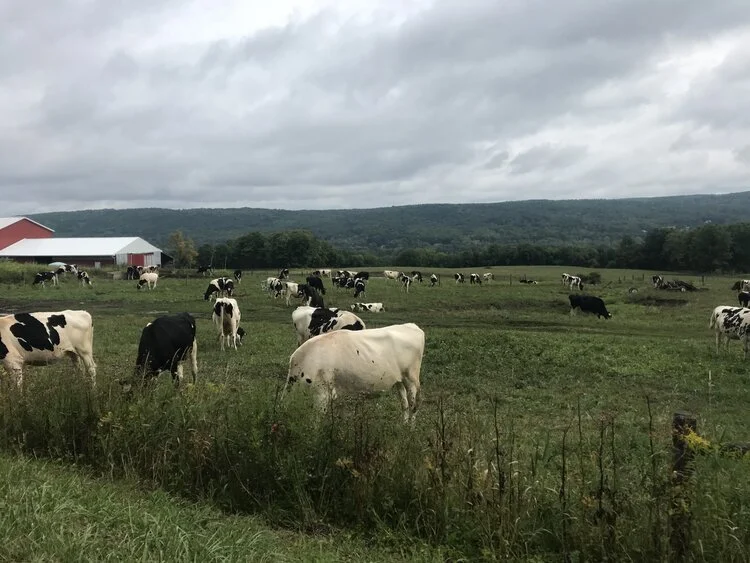Food Systems and Biodiversity
By Joseph While
Have you seen the movie Interstellar? Well, if you haven’t… the failure of agriculture creates a dystopian world where the only way to save humanity is to leave. Some blight (any type of plant disease) destroys the world supply of one staple crop after another, and the future is looking pretty bleak. I personally enjoy learning the science behind doomsday events, so I decided to research the validity of this type of scenario.
Turns out blights are already pretty common for a lot of different crops (obviously not yet to the scale of the collapse of the human race). What stood out to me was profound! The best way to avoid the collapse of the global food system is to protect biodiversity. So many processed food products come from the same few staple sources because they are cheap and easy, and there is a large steady supply.
Photo courtesy of Joseph While
THE PROBLEM: MODERN AGRICULTURE IS BAD FOR BIODIVERSITY
Let’s state the obvious: A growing population requires more food. The easiest way to increase food production as a grower is intensification or expansion, both of which harm biodiversity. But why is biodiversity important? Well, of the nine planetary boundaries for life on Earth, biodiversity loss is the most alarming.
Biodiversity impacts both environmental health and human health. Though agricultural intensification may increase the total crop yield of one or two staple crops, this reward is reaped at the cost of soil health, pollinator health, risk of blight, and obviously biodiversity. The long-term consequences could be catastrophic!
Agricultural expansion also accelerates biodiversity loss when natural areas such as forests and grasslands are destroyed at the expense of cheap food production. Deforestation and cultivation significantly increase the carbon footprint of agriculture when food production is already responsible for over a quarter of global GHG emissions. Biodiversity loss for both plants and animals unbalances the natural cycles of Earth, and creates unhealthy relationships between all living beings.
Improvements in the global food system should be good for alleviating world hunger right? Well, there was good news for most of the 21st century until around 2014. I recently attended a webinar with the International Food Policy Research Institute (IFPRI) to learn more about sustainability targets within agriculture. Organization representatives presented their 2020 report on the current state of food security and the numbers were shocking!
The IFPRI argues the main three reasons world hunger has risen by 60 million in the past five years is politics, environmental destruction, and inequality. While extreme poverty does remain on the decline, food insecurity is still rising (COVID-19 isn’t helping either), and over 3 billion people cannot afford a healthy nutritious diet. A healthy nutritious diet consists of a diverse well-balanced diet, not a diet saturated with modified rice, maize, and wheat. The 2020 SOFI report values the importance of quality nutrient-rich food instead of basing food security on quantity of calories alone (read our blog about an Astrapto client that raises palm weevil larvae for orphans in Africa as a culturally relevant, nutrient-dense, climate friendly alternative to beef, pork, etc.).
THE SOLUTION: WE CAN MAKE IT WORK, BUT IT WILL TAKE SOME EFFORT
UN SDGs #2 and #15 together highlight the importance of biodiversity in the development of a sustainable global food system. Goal 15 includes biodiversity in the argument for protecting all life on land, and Goal 2 incorporates food security and sustainable agriculture in the argument for ending global hunger. This is the future of food and we need to be talking about it more as the pressing issue surrounding the path towards sustainability.
We all have a carbon footprint when it comes to the food choices we make. When we think about diet and nutrition, biodiversity usually isn’t the first thing that comes to mind. Same thing with climate change: Biodiversity usually isn’t the headliner. Why not? Biodiversity is one of the key connectors for how our food systems can impact both the environment and personal health. Though biodiversity loss is one symptom of the current unhealthy agricultural system, biodiversity can also be incorporated as part of the solution. But where can we start implementing the solution as businesses or individual consumers?
HERE ARE SOME IDEAS ON HOW YOU CAN DRIVE CHANGE
Have you ever heard someone say “The more colors you have on your plate, the healthier it is for you”? The health benefits represented by the diversity of colors in food come from the diversity of nutrients in each food. Biodiversity is as much a key to a healthy diet as it is a key to a healthy planet. I challenge everyone to incorporate this simple nutrition trick into their food choices, because it very well may be part of the solution in preventing biodiversity loss.
Explore beyond meals you are comfortable with! 40% of all food comes from the three staple crops of rice, maize, and wheat; 95% of all meat comes from the same five species. Do you know how many more options for food there are out there!? The more diverse you make your meals, the more likely you are to have a well-balanced diet because your nutrients, vitamins, minerals, and your calories are diversified.
I like to think of nutrition diversity as your personal health stock portfolio: Create a hedge fund for your health by investing in as many diverse nutritious foods as you can. You are more likely to protect yourself as an investor in your own health, the more diverse you make your nutrient portfolio. And color is a great indicator of nutrient diversity to get started.
These small changes have a big impact when scaled-up beyond the individual. What if a large organization involved in the food industry makes it clear to their suppliers that they value biodiversity from the source? In the service industry you need to find any way to set yourself apart from the competition.
By expanding this individual choice in ingredient-sourcing to the restaurant and event-planning world, the question to ask is: Are the ingredients I am offering customers diverse enough? For anyone in the industry, taking a more farm-to-table approach is enticing, healthier, fresher, and just plain cooler to offer to your clients. In the age of innovation, internet and food blogging, you better not get caught serving boring dishes to your customers or we’re looking at a downvote on Yelp. Wouldn’t you rather have the free publicity surrounding your cool dishes than play it safe because it’s more comfortable? The win-win scenario simply: Healthy planet equals happy people. More biodiversity at the ingredient source will lead to happier and healthier consumers.
YOUR DECISIONS HAVE AN IMPACT ON DRIVING CHANGE
Our impact as consumers of food can help farms remain profitable, more resilient, and healthier for the environment and their local community too. By better incorporating biodiversity in the agricultural process, farmers can improve the health of their plants, land, and their customers. All of the biodiversity-related problems with monocropping can be solved by diversifying the field.
Pollinators will have a healthier living environment, and therefore will keep the crops healthy in return (Read more about that here)
Crop resilience and adaptability will increase, creating a self-regulating form of pest control
Soil health will improve as the nutrient cycle restores balance through the interaction of different plants
Increasing resilience and soil health reduces the need for artificial fertilizers, pesticides, and herbicides. Again, food grown in biodiverse environments will have the same or better yield, be healthier for the environment, and be healthier for the consumer. If it's good for the environment, good for personal health and good for business, isn’t it worth it to better value biodiversity in our food systems?





